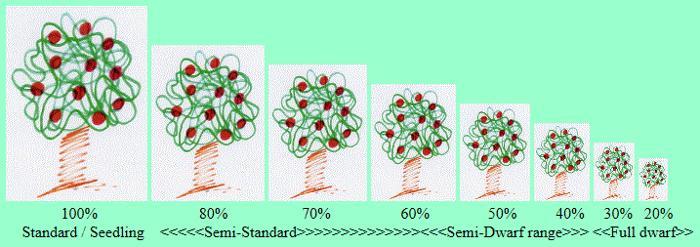NFG-Dwarf vs Semi-Dwarf vs Standard Trees

NFG-Dwarf vs Semi-Dwarf vs Standard Trees
What is under the ground is just as important as what is above the ground!
In a most cases with apples there is a lot of choice. For a lot of the other fruits, your choices are more limited. In any case, you need to determine how much level of "hands on" management you want to invest in your orchards. A general rule of thumb is that the more dwarfing the rootstock, then the more "management" you will have to invest in getting them off to a good start. This does not always mean more time and labor, but it often means more attention to detail because you really can't afford to make many mistakes in high intensity, full dwarf orchards as you can in semi-dwarf and standard root orchards.
For most stone fruits, you often have little choice in rootstock, since most fruit trees are grown on "standard" roots. The redeeming factor is that most stone fruits can be maintained at reasonable tree heights and limb spreads through good growing practices, especially pruning and fertilizing. One can even go to quite intense production at higher densities than are often used if you are a good manager. Most stone fruits can be planted in densities similar to semi-dwarf apples and pears.
Cherries are getting more new rootstocks. With the advent of size controlling and precocity enhancing rootstocks like Gisela® 5, then the opportunity for "high density" and early production is practical. Other Gisela® rootstocks like Gi 6 and 12 are less dwarfing, may only be slightly less precocious, and offer the opportunity to grow cherry orchards in densities similar to semi-dwarf apples. The newer Krymsk® rootstocks are competing with the Gisela®. Standard rootstocks for cherries are probably on their way out for most varieties and systems but will always have their place in certain situations.
Apples and Pears have good choices for rootstocks ranging from full dwarf (about 20-25% of the old standard, big apple tree of Grandpa's time) to Semi-Dwarf, (ranging from 40-75%) which many growers still like, to Semi-Standard (75-90%) which fewer growers continue to grow, although they definitely have their place in certain sites.
For the new fruit grower, who feels they have a steeper learning curve than most "newbies", I usually recommend semi-dwarf rootstocks for apples and pears, the ordinary standard rootstocks for most stone fruits, and the more "semi-dwarf" cherry rootstocks for cherry. This is because their management is less demanding, you have more opportunity to make "mistakes" without paying dearly for them and most can be planted in very similar planting densities, making equipment needs much less demanding and capital investment is moderate.
For the new grower, who feels they have more experience, or they feel a real need for "pedestrian orchards", high production, or who have committed themselves to being a real hands-on manager, then rootstocks in the full to a little less than full-dwarf range can be good choices.